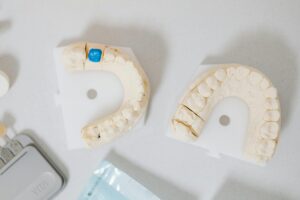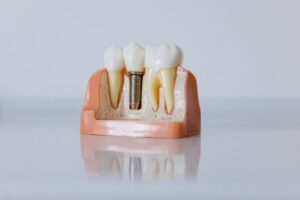In the evolving field of dentistry, innovative breakthroughs have paved the way for advanced tooth replacement options. People often ask if one dental implant can replace two missing teeth. This inquiry prompts a deeper look at the options. It also looks at the key factors needed to judge the solution’s effectiveness. Studying this subject shows that dental implants could offer an easy way to fix the problem. The problem is losing many teeth. They are effective too. It also shows the importance of custom dental strategies to meet specific needs.
Understanding Dental Implants
Dental implants are a modern solution for missing teeth. They effectively act like natural tooth roots. These prosthetic constructs have a titanium screw. It is placed in the jawbone through surgery. This process makes a strong base. It is for attaching one or more artificial teeth. Dental implants replicate natural roots. They are stable and reliable. They are a long-term option for dental restoration. They replace lost teeth. This addresses the need for both function and aesthetics. This new approach to dental care shows a big advance in the field. It gives people a seamless way to regain their smile and dental health.
Can One Implant Replace Two Teeth?
Is it possible for a single dental implant to substitute for two adjacent teeth? The concise response is affirmative; in certain scenarios, this is achievable. Yet, embarking on this route demands a meticulous evaluation of several critical aspects. These include the exact positioning of the missing teeth. Also, the health of the nearby teeth and gums. And the overall oral health of the person. Choosing one implant to serve as two requires thought. This balancing means weighing dental implant options. You weigh them against the patient’s dental profile and health. The profile and needs are unique. This method shows the importance of personalized dental solutions. It also shows the need for expert assessment to ensure the best outcomes.
Implant-Supported Bridges
An implant-supported bridge is a smart solution. It restores two missing teeth using just one implant. This new approach involves adding a dental implant. It acts as a pillar for a bridge that fills the gap left by the absent teeth. This bridge has two crowns. They are at the ends of a prosthetic tooth. They seamlessly fill the void left by the missing teeth. This method offers a practical and fast replacement. It also ensures a cohesive and pretty result. The dental implant provides stability. The implant-supported bridge is a testament to dental technology advancements. It offers a durable and reliable option for tooth replacement.
Gum Shaping for Aesthetic Results
Achieving the perfect blend of looks and function often requires gum shaping. This is especially true when a single implant is used to replace two teeth. This process is called gum contouring. It is a delicate procedure. It aims to sculpt the gum line to look like natural dental landscapes. Dental professionals carefully craft the gums’ indentations and contours. They do this to ensure that the prosthetic teeth fit and look like the natural teeth next to them. This careful gum shaping is crucial. It ensures that the fake teeth fit in well and look natural. It also makes the whole smile look better.
Preserving Adjacent Teeth and Bone
Choosing a single dental implant to replace two teeth has big benefits. It keeps the nearby teeth and jawbone intact. Traditional dental bridges are different. They often need the alteration of healthy neighbouring teeth to anchor them. A single implant bypasses this need. This approach spares the nearby teeth from changes. It also saves the bone and gum around the implant site. Dental implants are crucial. They prevent the atrophy of bone and gum tissues, which often happens after tooth loss. Dental implants maintain the structure and health of these tissues. They ensure a foundation for oral health. This foundation supports not just the implant area. It also supports the patient’s dental health.
The Dental Implant Process
The process of receiving a dental implant typically involves several stages. First, the team conducts a thorough exam. It assesses the patient’s oral health and decides if they are suitable for the procedure. Next, the dental implant is surgically placed into the jawbone. It will combine with the bone tissue around it in a process called osseointegration.
Once the implant has fully integrated, a custom-made crown or bridge is attached to it. This completes the restoration. Technology has advanced. CAD/CAM tech allows for precise planning and making of dental restorations. It ensures they have the best fit and look.
Also read: How Much Do Dental Implants Cost in Scotland?
Benefits of Implant-Supported Bridges
Implant-supported bridges offer several benefits over traditional dental bridges:
- Uncompromised Integrity of Adjacent Teeth: The health of nearby teeth is hurt by the traditional approach. Don’t hurt them. The bridges stand on their own with the strength of pillars. They bypass the need to alter your natural teeth. This innovation ensures your adjacent teeth remain untouched, preserving their strength and integrity.
- Seamless Aesthetic Integration: Imagine a smile so natural. It’s impossible to tell the difference between your natural teeth and the dental work. That’s the promise of implant-supported bridges. We use expert gum shaping and custom restorations. They guarantee a seamless match with your natural teeth. They create a smile that’s both beautiful and authentic.
- Unwavering Stability and Functionality: Anchor your smile. Dental implants provide the solid base it needs. Our implant-supported solutions are different from traditional bridges. They are rooted in stability and remove worries about shifting or movement. This steadfastness keeps your bridge fitting, functioning, and looking perfect. It will stay that way for a long time. It lets you enjoy life without holding back.
Conclusion
It is possible for one dental implant to replace two missing teeth. But, careful planning and thought are needed to ensure the best results. Implant-supported bridges offer a good way to replace many missing teeth. They do this while keeping nearby teeth and supporting oral health. Consider dental implants to replace teeth. Talk to a qualified dentist. They will help you find the best treatment for your needs.
Ready to Transform Your Smile? Contact Dental Implant Aberdeen Today!
Considering the option of a single dental implant to replace two teeth? Let Dental Implant Aberdeen guide you. They will guide you to the best solution for your needs. We are committed to excellence. It ensures that your journey to a perfect smile is smooth, comfortable, and fulfilling. Contact us today to schedule a consultation. It’s the first step towards restoring your confidence and smile.
Also read: How Much Are All-On-4 Dental Implants in the UK?
Frequently Asked Questions
Is replacing two teeth with one implant common?
Many people are choosing it because it has benefits. These include less surgery and keeping nearby teeth.
What are the benefits of using one implant for two teeth?
The benefits include:
- less invasive surgery,
- cost-effectiveness,
- preserving the integrity of surrounding teeth, and
- maintaining jawbone health.
How does an implant support two teeth?
An implant acts as a root for a bridge. The bridge spans the gap and supports two artificial crowns. The implant does this without affecting adjacent teeth.
Are there aesthetic differences with this method?
No, if done professionally, this method looks natural. It blends seamlessly with surrounding teeth.
What’s the success rate for single implants replacing two teeth?
With proper placement and care, the success rate is high. It is similar to traditional single-tooth implants.
How do I know if I’m a candidate for this procedure?
You need a dental evaluation. It will consider your oral health, bone density, and specific needs. The evaluation is necessary to determine if you are suitable.
Related Article: How Long Do Dental Implants Last?






